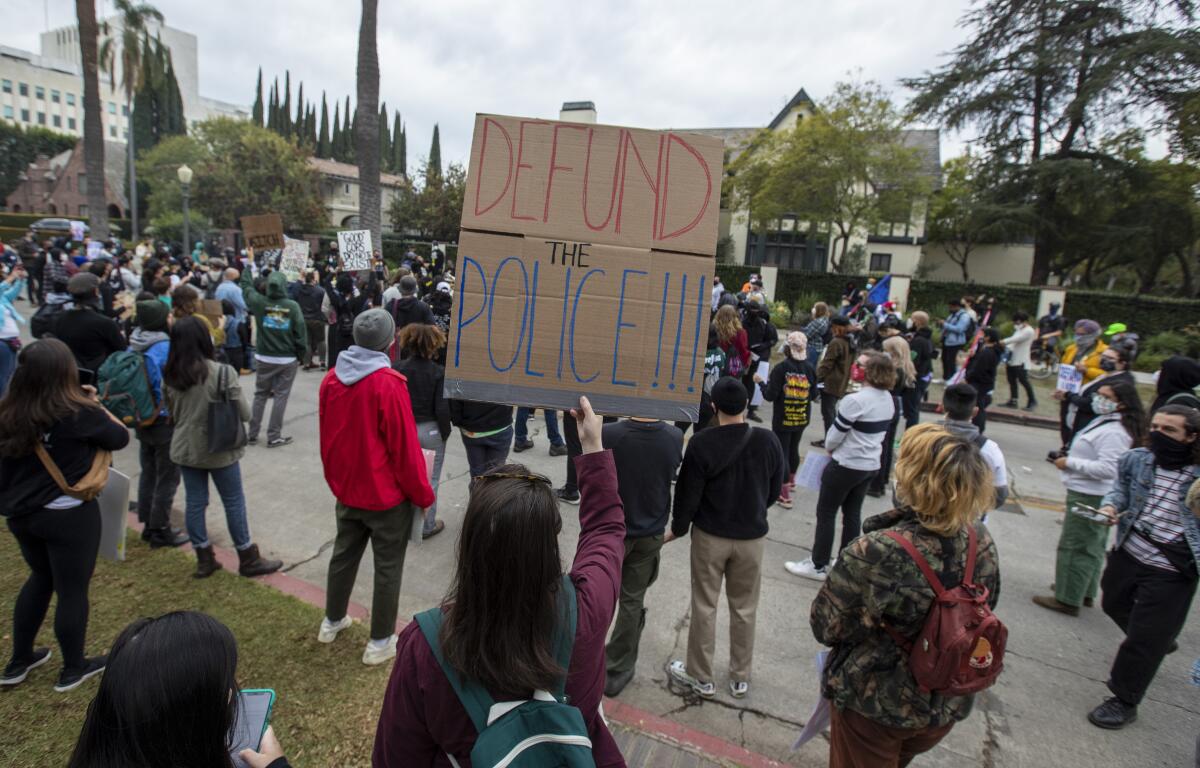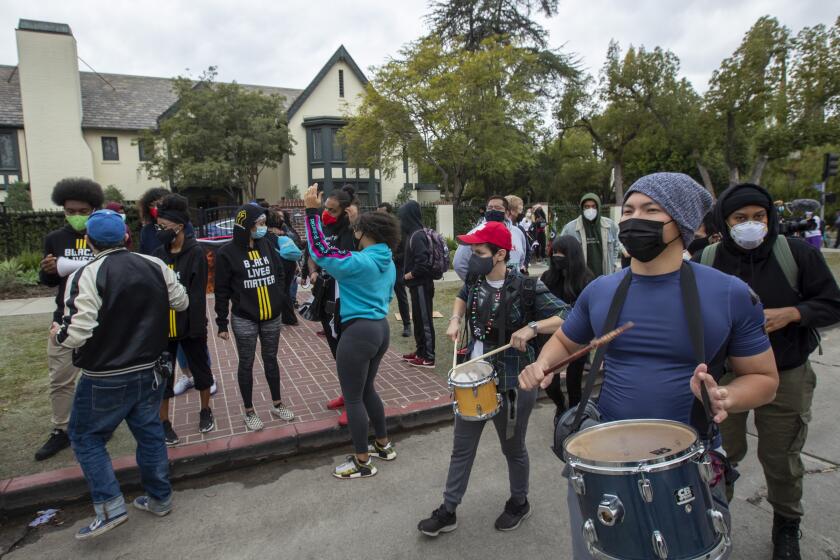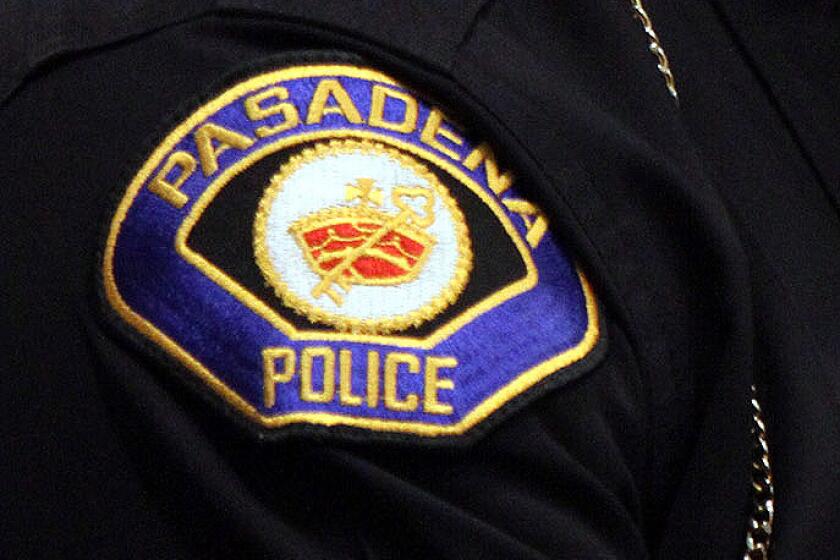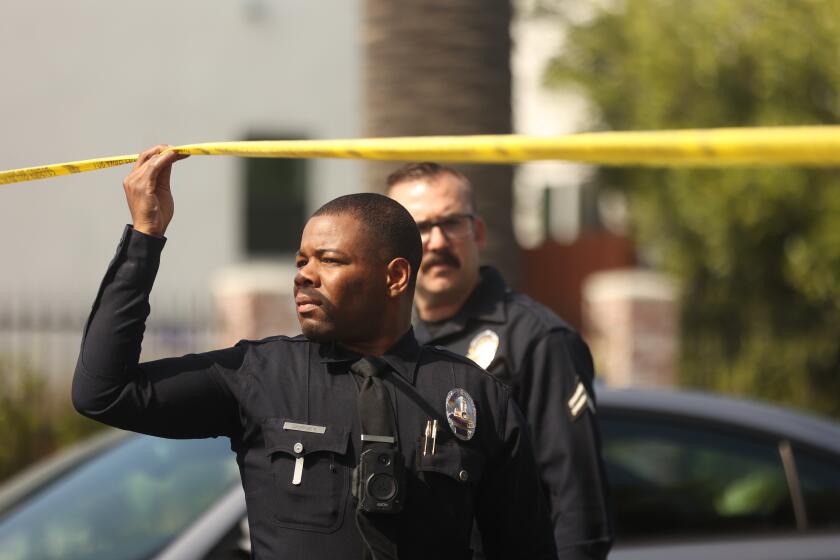L.A. cracks down on ‘out of control’ protests. Some call it overreach

- Share via
Members of the Los Angeles City Council largely stood back last year as protesters angry over mask mandates and police budgets regularly held noisy demonstrations outside politicians’ homes.
On Tuesday, members of the City Council sent a message of their own: They’ve had enough.
The City Council gave final approval to a law that requires a 300-foot buffer around a private residence targeted for demonstration and imposes fines for violators. The council also passed new laws intended to crack down on disruptive behavior at City Hall and forbid visitors from carrying Mace, knives and similar items into city facilities.
The council votes signaled City Hall’s pushback to the in-your-face tactics of activists on both the left and the right, protests that used bullhorns, marches and moving cars, as well as more aggressive tactics.
The demonstrations, part of nationwide trend of activists targeting the private residences of officials, started when many government buildings closed because of the pandemic.
In some cities, demonstrators left behind property damage. In Oakland, the home of Mayor Libby Schaaf was vandalized. In Sacramento, Mayor Darrell Steinberg’s home was hit with rocks. And the Portland, Ore., home of a city commissioner was damaged after a city vote against defunding the police.
City Council President Nury Martinez, whose Sun Valley home has repeatedly been targeted by demonstrators, said Tuesday that the tone of the protests is now “completely out of control.” She also said she’s concerned that violence will break out and that the law over protesting isn’t about “silencing any voices.”
The L.A. City Council voted to limit protests outside residences, passing a law that lets targets and others seek fines from unlawful demonstrators.
“This is about protecting our family members, our children, and our neighbors from aggressive, targeted protests at all hours of the day and night,” Martinez said. “When you come onto my street to yell on bullhorns outside of my home, you’re not only disrespecting my family, but you’re also disrespecting the community and neighbors who live there.”
Attorneys who focus on 1st Amendment rights questioned why the council isn’t using existing laws to address trespassing or targeted threats.
Peter Eliasberg, chief counsel for the American Civil Liberties Union of Southern California, said the Los Angeles Police Department has a history of mass arrests and misuse of force. Giving officers another ordinance to enforce is “an invitation for trouble.”
“I am concerned about this type of legislation that says, ‘Let’s make it that much harder to protest,’” Eliasberg said, referring to the new 300-foot buffer law.
City officials modeled the law after one in San Jose, noting the law has survived legal challenges.
Attorney Carol Sobel, who has prevailed in several lawsuits against the city, said that she expects the courts to strike down the ordinance. “If you don’t like it, get another job,” Sobel said of politicians who are unhappy about the protests.
Protesters hit the streets at the start of the pandemic, with demonstrators calling for rent eviction moratoriums and more. At the same time, groups opposed to mask mandates demonstrated outside City Hall and Getty House, the official residence of L.A.’s mayor.
Then, the murder of George Floyd by a police officer in Minneapolis prompted widespread marches and elevated the work of Black Lives Matter-Los Angeles. The City Council responded by cutting $150 million from the LAPD budget and focusing its next budget more narrowly on social justice.
People saw the success of Black Lives Matter and the marches, said political consultant Jasmyne Cannick.
“Other groups saw that strategy worked,” Cannick said. “Through protesting they saw change can come about.”
Supporters of the new laws pointed to the property damage and violent rhetoric employed by protesters.
Martinez’s car was vandalized earlier this summer by two individuals who also wrote the phrase “end the sweeps” on her driveway, a reference to the city’s sweeps of homeless encampments that require people to remove their tents. Demonstrators also defaced Getty House in July.
At a recent anti-vaccination rally in Santa Monica, local activist
Jason Lefkowitz warned that if a vaccination mandate under consideration by the City Council passes, activists should “get your guns.” The speaker also released City Council members’ addresses, according to video of the event.
Lefkowitz, on Twitter, denied that he said that people should take weapons to other people’s homes. “I said to prepare for what’s coming to their own door,” he wrote.
The LAPD interviewed Lefkowitz and determined that the words and statements fall under 1st Amendment-protected activity, LAPD spokesman Raul Jovel said.
In a year that kicked off with the deadly Jan. 6 attack on the U.S. Capitol, threats against lawmakers are soaring. In the first three months of 2021, the U.S. Capitol Police recorded 4,135 threats against members of Congress. If that pace continues, total threats this year will double those in 2020.
Despite restrictions barring people from attending Los Angeles City Council meetings because of COVID-19, City Council members moved to rein in the behavior of those visiting City Hall.
At a committee meeting last week, council members considered the proposed laws to crack down on unruly behavior and bar weapons from the building.
At one point, City Councilman Joe Buscaino said “more consequences around City Hall” are needed. The councilman, referring to public meetings before the pandemic, cited the “disruptions in the hallways” and “the childish behavior from knuckleheads who frequent our buildings.”
Under the law focused on unruly behavior, police officers can issue citations for actions such as scrawling on city property, singing without authorization or sitting on the floor of a building, according to a presentation on the ordinance by Chief Assistant City Atty. David Michaelson.
Police are investigating a vandalism incident at the home of Los Angeles City Council President Nury Martinez.
Violators are subject to fines of $100 for the first offense. A second violation and subsequent ones are subject to fines of $250 or prosecution as a misdemeanor.
The law states that no person shall remain on a property operated by the city “in violation of a posted rule promulgated by the department head pursuant to the Charter to ensure the preservation, maintenance, efficient and effective management, and safe use of property and facilities by the public and city employees.”
The other law supported by the City Council bans people from entering city buildings while carrying Mace, box cutters, martial arts weapons and other banned items. The law allows officers to search visitors and their belongings at any time.
Opponents of that law portrayed it as overreach, particular as it pertains to items carried by more vulnerable populations.
“Should a woman taking Metro to the library be unable to bring pepper spray [into facilities?]” asked Rob Quan, who runs Unrig L.A., an activist group focused on issues of representative government and money in politics. “What about the unhoused residents carrying their only belongings? Should they not be able to enter a city facility to get the services they need to find housing?”
The two ordinances focused on barring weapons and unruly behavior at government buildings were presented to City Council members several years ago but didn’t move forward until recently, Michaelson said.
More to Read
Sign up for Essential California
The most important California stories and recommendations in your inbox every morning.
You may occasionally receive promotional content from the Los Angeles Times.
















